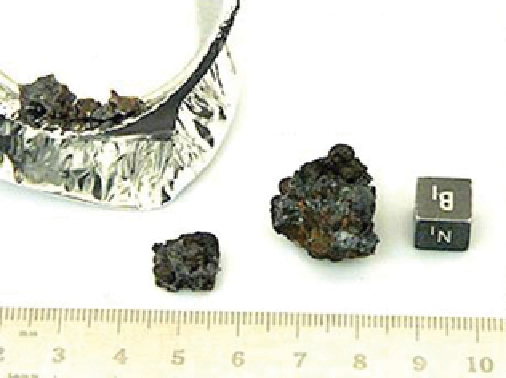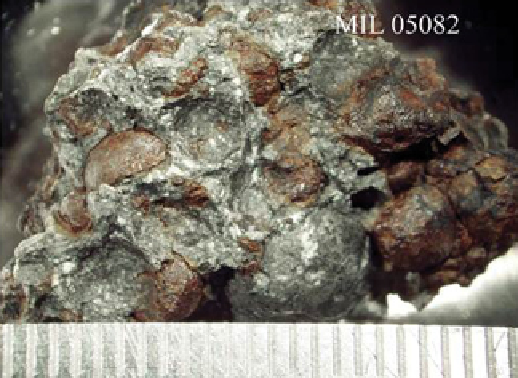Geology Reference
In-Depth Information
CB
b
chondrite
11.98 g
Found December 6, 2005
2.5 × 1.8 × 2.3 cm
Weathering = B
chondrites. They contain high modal contents of metal, as well as CAis
and chondrules. Between the coarser-grained components is a thin layer of
intimately intermixed glass and metallic quench liquids that formed upon
shock of the meteorite. The hydrated matrix that is found in most other
carbonaceous chondrites is largely missing; the only remnant is interstitial
glass and very rare hydrated clasts. CB
b
chondrites are generally coarse
grained in texture with up to ~5 mm chondrules and metal grains.
MIL 05082
,3
,0
,1
1. 0
0.5
-0.3
-0.2
-0.1
0.0
0.1
-0.6
-0.5
-0.4
-0.5
-1.0
MIL 05082
Gujba (this study)
Gujba (Cook et al. 2006)
-1.5
ε
60
Plate 22
MiNERALogy
SigNiFiCANCE
Subequal amounts of metal and sulfide, with rounded
metal particles up to 4 mm in diameter. Chondrules and
chondrule fragments up to 0.5 mm are dominated by
radiating pyroxene textures. Silicates are magnesian
(Fa
1-3
, Fs
1-3
).
The bulk composition of MiL 05082 indicates that there
was little or no metal-silicate fractionation between the
major components of the meteorite (nor was there modi-
fication from original nebular origin; left). Amino acids
in CB chondrites are abundant and structurally distinct
from other carbonaceous chondrite groups. MiL 05082
comprises primitive chondritic materials, little modified
since nebular times, and isotopic studies reveal that
60
Fe
was not distributed homogeneously throughout the early
solar system (right, [133]).
References [131-133]




